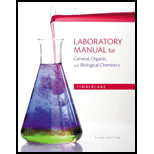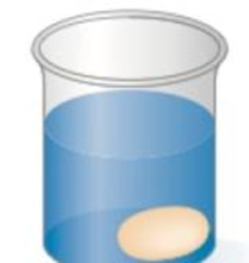
EBK LABORATORY MANUAL FOR GENERAL, ORGA
3rd Edition
ISBN: 9780321918352
Author: Timberlake
Publisher: YUZU
expand_more
expand_more
format_list_bulleted
Concept explainers
Textbook Question
Chapter 8, Problem 8.95AP
Consider a cell placed in solution as shown in the following figure:

If tlte inside of the cell has a concentration equivalent to 0.90% (m/v) NaCl, is the cell in a hypertonic, hypotonic, or isotonic solution if the solution outside of the cell is the following:
- a. 5% NaCl
- b. 0.090% NaCl
- c. 0.90% NaCl
Expert Solution & Answer
Want to see the full answer?
Check out a sample textbook solution
Students have asked these similar questions
Can someone explain this?
5. Drawn the structure of the compound (molecular formula C12H16) with the longest λmax in its
UV-vis spectrum.
Use solubility rules to complete balance molecular equations, and provide total and net ionic equations.
Chapter 8 Solutions
EBK LABORATORY MANUAL FOR GENERAL, ORGA
Ch. 8 - Prob. 8.1PPCh. 8 - Prob. 8.2PPCh. 8 - Prob. 8.3PPCh. 8 - Prob. 8.4PPCh. 8 - Prob. 8.5PPCh. 8 - Prob. 8.6PPCh. 8 - Prob. 8.7PPCh. 8 - Prob. 8.8PPCh. 8 - Explain what is happening in the following...Ch. 8 - Explain what is happening in the following...
Ch. 8 - Where would you expect a freshly poured glass of...Ch. 8 - Hyperbaric oxygen chambers contain 100 percent...Ch. 8 - Predict if the following will fully' dissociate,...Ch. 8 - Prob. 8.14PPCh. 8 - Provide a balanced equation for the hydration of...Ch. 8 - Prob. 8.16PPCh. 8 - Prob. 8.17PPCh. 8 - Prob. 8.18PPCh. 8 - How many equivalents of K+ ore present in a...Ch. 8 - Prob. 8.20PPCh. 8 - Prob. 8.21PPCh. 8 - Prob. 8.22PPCh. 8 - Prob. 8.23PPCh. 8 - Prob. 8.24PPCh. 8 - Prob. 8.25PPCh. 8 - Prob. 8.26PPCh. 8 - Prob. 8.27PPCh. 8 - Prob. 8.28PPCh. 8 - Prob. 8.29PPCh. 8 - Prob. 8.30PPCh. 8 - Prob. 8.31PPCh. 8 - Calculate the percent mass, volume (% m/v) for the...Ch. 8 - (Calculate the percent mass/Volume (% m/v) for the...Ch. 8 - What is the concentration in % (m/m) of a solution...Ch. 8 - Prob. 8.35PPCh. 8 - Prob. 8.36PPCh. 8 - What is the concentration in ppm of a solution...Ch. 8 - Prob. 8.38PPCh. 8 - How many liters of a 0.90% (m/v) NaCl solution can...Ch. 8 - Prob. 8.40PPCh. 8 - What would the concentration of the resulting...Ch. 8 - Prob. 8.42PPCh. 8 - How would you prepare 250 mL of a 0.225% (m/v)...Ch. 8 - Prob. 8.44PPCh. 8 - Prob. 8.45PPCh. 8 - Prob. 8.46PPCh. 8 - Prob. 8.47PPCh. 8 - Prob. 8.48PPCh. 8 - Prob. 8.49PPCh. 8 - Prob. 8.50PPCh. 8 - Prob. 8.51PPCh. 8 - Prob. 8.52PPCh. 8 - Prob. 8.53PPCh. 8 - Identity the type of transport (passive diffusion,...Ch. 8 - Prob. 8.55APCh. 8 - Prob. 8.56APCh. 8 - Prob. 8.57APCh. 8 - Prob. 8.58APCh. 8 - Does the solubility of the solute increase or...Ch. 8 - Prob. 8.60APCh. 8 - Prob. 8.61APCh. 8 - Would you expect the concentration of oxygen in...Ch. 8 - Prob. 8.63APCh. 8 - Prob. 8.64APCh. 8 - Prob. 8.65APCh. 8 - Provide a balanced equation for the hydration of...Ch. 8 - Prob. 8.67APCh. 8 - Prob. 8.68APCh. 8 - Prob. 8.69APCh. 8 - Prob. 8.70APCh. 8 - Prob. 8.71APCh. 8 - Prob. 8.72APCh. 8 - Prob. 8.73APCh. 8 - Prob. 8.74APCh. 8 - Prob. 8.75APCh. 8 - Prob. 8.76APCh. 8 - A 750 mL bottle of wine contains 12% (v/v)...Ch. 8 - Prob. 8.78APCh. 8 - Prob. 8.79APCh. 8 - Prob. 8.80APCh. 8 - How many grams of dextrose are in 800 mL of a 5%...Ch. 8 - Prob. 8.82APCh. 8 - Prob. 8.83APCh. 8 - Prob. 8.84APCh. 8 - Prob. 8.85APCh. 8 - Prob. 8.86APCh. 8 - Prob. 8.87APCh. 8 - Prob. 8.88APCh. 8 - Prob. 8.89APCh. 8 - How would you prepare 500 mL of a 5% D5W (dextrose...Ch. 8 - Prob. 8.91APCh. 8 - Prob. 8.92APCh. 8 - Prob. 8.93APCh. 8 - Prob. 8.94APCh. 8 - Consider a cell placed in solution as shown in the...Ch. 8 - Prob. 8.96APCh. 8 - Edema, commonly referred to as water retention, is...Ch. 8 - Prob. 8.98APCh. 8 - Prob. 8.99APCh. 8 - Prob. 8.100APCh. 8 - Prob. 8.101APCh. 8 - Prob. 8.102APCh. 8 - Prob. 8.103CPCh. 8 - Prob. 8.104CPCh. 8 - Two containers of equal volume are separated by a...Ch. 8 - Proteinuria is a condition in which excessive...Ch. 8 - Prob. 8.107CPCh. 8 - Prob. 1IA.1QCh. 8 - Prob. 1IA.2QCh. 8 - Describe the appearance of the foods in (a) the...Ch. 8 - Prob. 2IA.2QCh. 8 - Prob. 2IA.3QCh. 8 - Prob. 2IA.4QCh. 8 - Which of the solutions (tap water or saltwater) is...Ch. 8 - Prob. 2IA.6QCh. 8 - If a person pours a concentrated saltwater...Ch. 8 - If a person drinks too much water too quickly, a...Ch. 8 - Prob. 1ICCh. 8 - Prob. 2ICCh. 8 - Prob. 3IC
Knowledge Booster
Learn more about
Need a deep-dive on the concept behind this application? Look no further. Learn more about this topic, chemistry and related others by exploring similar questions and additional content below.Similar questions
- Use the literature Ka value of the acetic acid, and the data below to answer these questions. Note: You will not use the experimental titration graphs to answer the questions that follow. Group #1: Buffer pH = 4.35 Group #2: Buffer pH = 4.70 Group #3: Buffer pH = 5.00 Group #4: Buffer pH = 5.30 Use the Henderson-Hasselbalch equation, the buffer pH provided and the literature pKa value of acetic acid to perform the following: a) calculate the ratios of [acetate]/[acetic acid] for each of the 4 groups buffer solutions above. b) using the calculated ratios, which group solution will provide the best optimal buffer (Hint: what [acetate]/[acetic acid] ratio value is expected for an optimal buffer?) c) explain your choicearrow_forwardHow would you prepare 1 liter of a 50 mM Phosphate buffer at pH 7.5 beginning with K3PO4 and 1 M HCl or 1 M NaOH? Please help and show calculations. Thank youarrow_forwardDraw the four most importantcontributing structures of the cation intermediate thatforms in the electrophilic chlorination of phenol,(C6H5OH) to form p-chlorophenol. Put a circle aroundthe best one. Can you please each step and also how you would approach a similar problem. Thank you!arrow_forward
- A 100mM lactic acid/lactate buffer was found to have a lactate to lactic acid ratio of 2 and a pH of 4.2. What is the pKa of lactic acid? Can you please help show the calculations?arrow_forwardUsing line angle formulas, draw thestructures of and name four alkanes that have total of 7carbons, one of which is tertiary.Please explain this in detail and can you also explain how to approach a similar problem like this as well?arrow_forwardUsing dashed line wedge projections drawthe indicated compounds and indicate whether thecompound you have drawn is R or S.(a) The two enantiomers of 2-chlorobutane. Can you please explain your steps and how you would approach a similar problem. Thank you!arrow_forward
- 5) There are no lone pairs shown in the structure below. Please add in all lone pairs and then give the hybridization scheme for the compound. (8) 10,11 7) 1.2.3 H 4 | 14 8) COC 12 13 H 16 15 H7 9) - 5.6 C 8 H 10) H 1). 2) 3)_ 11) 12) 13) 4)_ 14) 5) 15) 16) 6)arrow_forwardThe sum of the numbers in the name of isA. 11; B. 13; C. 10; D. 12; E. none of the other answers iscorrect. I believe the awnser should be E to this problem but the solution to this problem is D 12. I'm honestly unsure how that's the solution. If you can please explain the steps to this type of problem and how to approach a problem like this it would be greatly appreciated!arrow_forwardConsider the following data for phosphorus: g atomic mass 30.974 mol electronegativity 2.19 kJ electron affinity 72. mol kJ ionization energy 1011.8 mol kJ heat of fusion 0.64 mol You may find additional useful data in the ALEKS Data tab. Does the following reaction absorb or release energy? 2+ + (1) P (g) + e → P (g) Is it possible to calculate the amount of energy absorbed or released by reaction (1) using only the data above? If you answered yes to the previous question, enter the amount of energy absorbed or released by reaction (1): Does the following reaction absorb or release energy? 00 release absorb Can't be decided with the data given. yes no ☐ kJ/mol (²) P* (8) + + + e →>> P (g) Is it possible to calculate the amount of energy absorbed or released by reaction (2) using only the data above? If you answered yes to the previous question, enter the amount of energy absorbed or released by reaction (2): ☐ release absorb Can't be decided with the data given. yes no kJ/mol аarrow_forward
arrow_back_ios
SEE MORE QUESTIONS
arrow_forward_ios
Recommended textbooks for you
- Chemistry: Matter and ChangeChemistryISBN:9780078746376Author:Dinah Zike, Laurel Dingrando, Nicholas Hainen, Cheryl WistromPublisher:Glencoe/McGraw-Hill School Pub Co
 Chemistry for Today: General, Organic, and Bioche...ChemistryISBN:9781305960060Author:Spencer L. Seager, Michael R. Slabaugh, Maren S. HansenPublisher:Cengage Learning
Chemistry for Today: General, Organic, and Bioche...ChemistryISBN:9781305960060Author:Spencer L. Seager, Michael R. Slabaugh, Maren S. HansenPublisher:Cengage Learning  Introductory Chemistry: A FoundationChemistryISBN:9781337399425Author:Steven S. Zumdahl, Donald J. DeCostePublisher:Cengage Learning
Introductory Chemistry: A FoundationChemistryISBN:9781337399425Author:Steven S. Zumdahl, Donald J. DeCostePublisher:Cengage Learning Chemistry: The Molecular ScienceChemistryISBN:9781285199047Author:John W. Moore, Conrad L. StanitskiPublisher:Cengage Learning
Chemistry: The Molecular ScienceChemistryISBN:9781285199047Author:John W. Moore, Conrad L. StanitskiPublisher:Cengage Learning Chemistry: Principles and ReactionsChemistryISBN:9781305079373Author:William L. Masterton, Cecile N. HurleyPublisher:Cengage Learning
Chemistry: Principles and ReactionsChemistryISBN:9781305079373Author:William L. Masterton, Cecile N. HurleyPublisher:Cengage Learning

Chemistry: Matter and Change
Chemistry
ISBN:9780078746376
Author:Dinah Zike, Laurel Dingrando, Nicholas Hainen, Cheryl Wistrom
Publisher:Glencoe/McGraw-Hill School Pub Co

Chemistry for Today: General, Organic, and Bioche...
Chemistry
ISBN:9781305960060
Author:Spencer L. Seager, Michael R. Slabaugh, Maren S. Hansen
Publisher:Cengage Learning


Introductory Chemistry: A Foundation
Chemistry
ISBN:9781337399425
Author:Steven S. Zumdahl, Donald J. DeCoste
Publisher:Cengage Learning

Chemistry: The Molecular Science
Chemistry
ISBN:9781285199047
Author:John W. Moore, Conrad L. Stanitski
Publisher:Cengage Learning

Chemistry: Principles and Reactions
Chemistry
ISBN:9781305079373
Author:William L. Masterton, Cecile N. Hurley
Publisher:Cengage Learning
Solutions: Crash Course Chemistry #27; Author: Crash Course;https://www.youtube.com/watch?v=9h2f1Bjr0p4;License: Standard YouTube License, CC-BY